

Matt Campbell
2026 Hyundai Tucson Hybrid review
7 Hours Ago
The Hyundai Tucson is no longer a wallflower, with extroverted styling backed up by some serious substance.

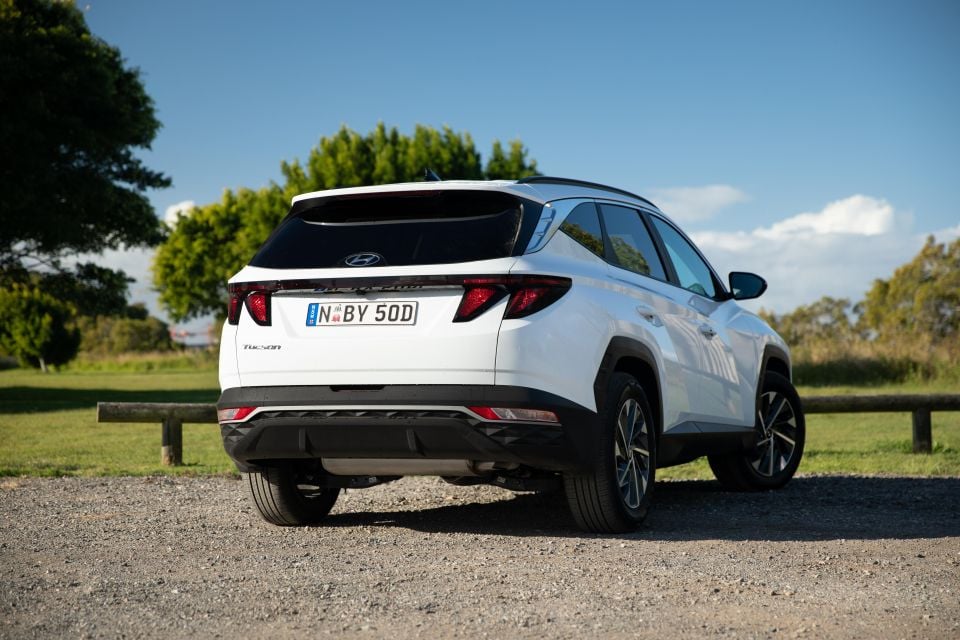

News Editor
New from
$29,640
excl. on-roads

News Editor
New from
$29,640
excl. on-roads


News Editor
New from
$29,640
excl. on-roads

News Editor
New from
$29,640
excl. on-roads
Quickly see how this car stacks up against its competition. Select any benchmark to see more details.
Where expert car reviews meet expert car buying – CarExpert gives you trusted advice, personalised service and real savings on your next new car.
You won’t miss the redesigned Hyundai Tucson.
No matter where you look, there’s a lot going on. The multi-part LED daytime running lights give the appearance of a partially-illuminated grille, while the Tucson features split-level lighting like the rest of Hyundai’s crossover line-up. The side creasing is extremely defined, while the tail lights resemble claws.
There’s even trim pieces with a geometric, textured pattern to be found on the rear bumper and by the daytime running lights.

You’ll have to form your own opinion as to whether you like it, though it’s important to note two things: one, white is virtually never a flattering colour and two, I’ve found the Tucson blends into traffic more easily than its controversial detailing first suggests.
You may also notice it looks a lot bigger than last year’s model. Australia, along with markets like Korea and North America, get a new long-wheelbase variant. It measures 4630mm long, 1865mm wide, and 1665mm tall with a 2755mm wheelbase. That makes it 150mm longer and 15mm wider than the previous generation, while the wheelbase alone has swelled by 85mm.
There’s more sophisticated safety technology like a radar-based rear seat occupant alert and a safe exit warning that stops passengers from stepping out into oncoming traffic, while the blind-spot and rear cross-traffic detection now actively stop you from getting into trouble.
With three engines and three trim levels available, we’ve put the mid-range Elite to the test with the entry-level engine.
The redesigned Tucson line-up comprises three trim levels – base, Elite and Highlander – that are all available with a new N Line package (coming soon). In turn, the Elite and Highlander are available with all three of the Tucson’s powertrains while the base model only offers one.
The Tucson range opens at $34,500 before on-roads for the base 2.0-litre petrol, climbing to $53,000 list for the Highlander with the diesel and the N Line package.
Our tester was the mid-range Elite, sans the N Line package and equipped with the base 2.0-litre four-cylinder engine. It’s priced at $39,000 before on-roads, $800 more than last year’s Elite. That works out to a $42,977 drive-away price based on a New South Wales postcode.
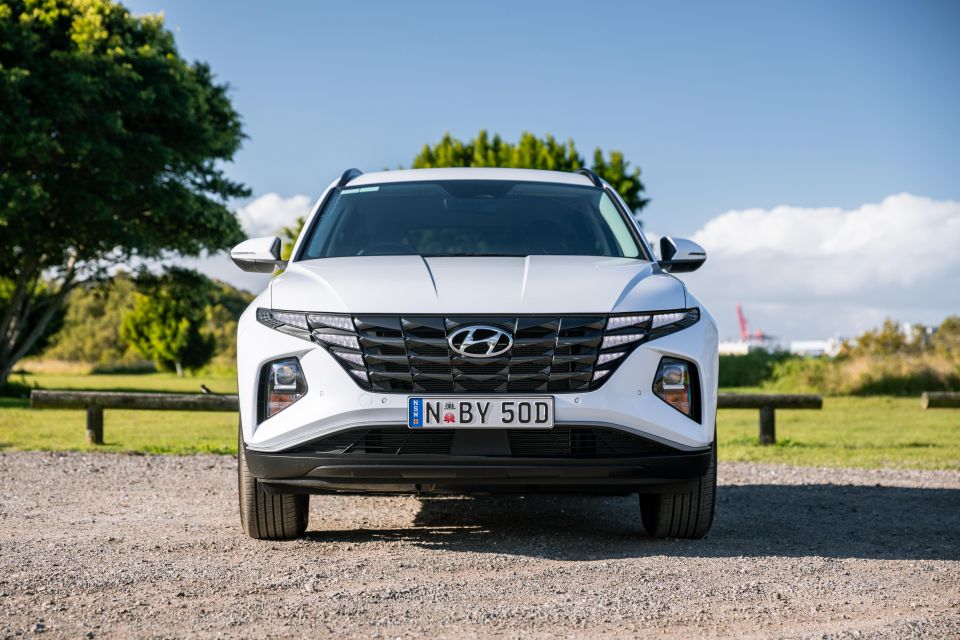
Premium paint is a $595 option. Finishes comprise Titan Grey, Amazon Grey, Deep Sea, Phantom Black and Shimmering Silver – in other words, the typical “multiple greys plus a dark blue” palette of many modern cars. Any of these colours are an improvement over the standard White Cream, however.
If you want to upgrade to the turbocharged 1.6-litre with all-wheel drive, you’re looking at a steep $4000 premium while the turbo-diesel asks for $6000 over the standard model. Finally, the N Line package is an extra $2000.
This is the mid-sized SUV segment we’re talking about, so there’s a staggering amount of variety. For roughly the same price (excluding on-roads), you can get a Ford Escape ST-Line FWD ($37,990), Jeep Cherokee Sport ($37,950), Mazda CX-5 Maxx Sport 2.0 FWD ($36,490) and 2.5 AWD ($39,490), Renault Koleos Zen ($36,790), updated Subaru Forester 2.5i-L ($38,390), Toyota RAV4 GXL ($37,415) and GXL Hybrid ($39,915) and Volkswagen Tiguan 110TSI Life ($39,690).
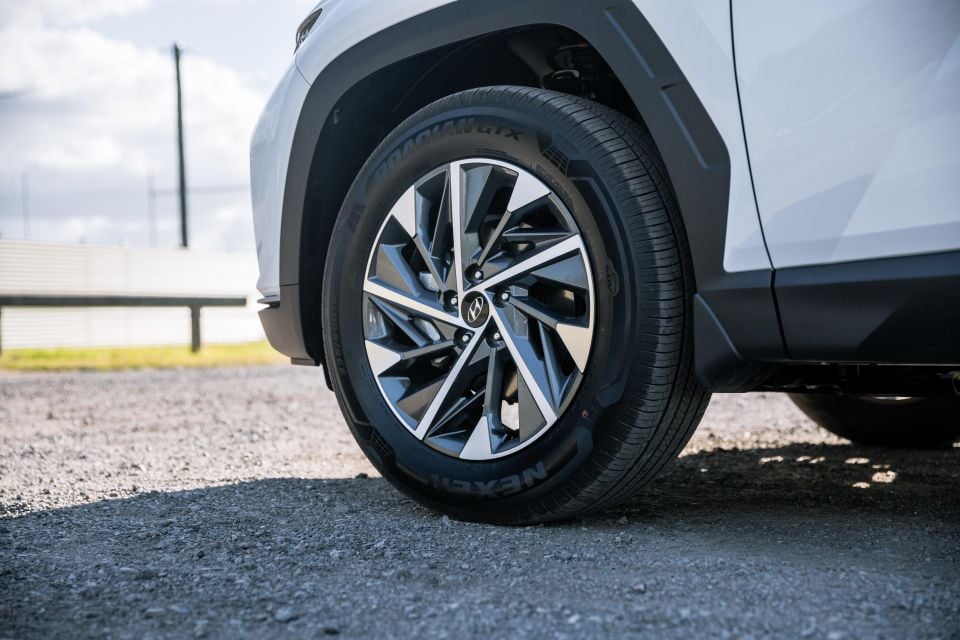
The all-wheel drive MG HS Essence and Haval H6 Ultra are two Chinese rivals making a sharp value play, both priced at $38,990 drive-away. The Korean Ssangyong Korando Ultimate is another model with nationwide drive-away pricing and, though it doesn’t offer all-wheel drive with its petrol engine, it rings in at $37,990 drive-away.
There are also several models that will soon be replaced. The Kia Sportage, which will use the new Tucson’s platform, can be had in SX+ guise for $38,790 before on-roads. Then there’s the Nissan X-Trail ST-L ($38,525) and Mitsubishi Outlander LS AWD ($37,990).
Perhaps the toughest competition from an established brand is the RAV4, the segment’s best-seller, which packs an almost identical feature list in GXL guise but a hybrid powertrain that’s more refined, responsive and fuel-efficient for ust under $1000 more.
The likes of the Korando and the Chinese offerings also offer the lower prices and longer feature lists that Hyundai once did when it was a challenger brand instead of part of the mainstream, while the Ford Escape is the performance hero of the under-$40k mid-sized SUV segment.
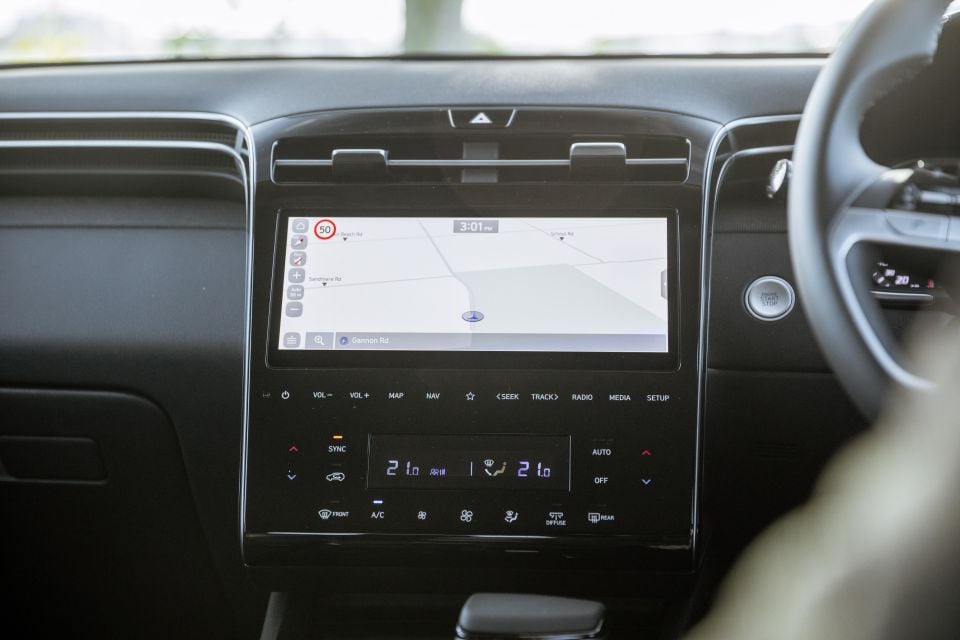
Buy your new car without the stress. It's fast, simple and completely free.

Great service from Travis and team, second time I have used this business would not hesitate to recommend them to anyone
Craig C.
Purchased a Ford Ranger in Sunshine Coast, QLD
CarExpert helped Craig save thousands on his Ford Ranger, now let us save you on your next new car.
Find a dealThe Tucson Elite comes standard with the following features:
That’s in addition to features found on the base Tucson, such as:
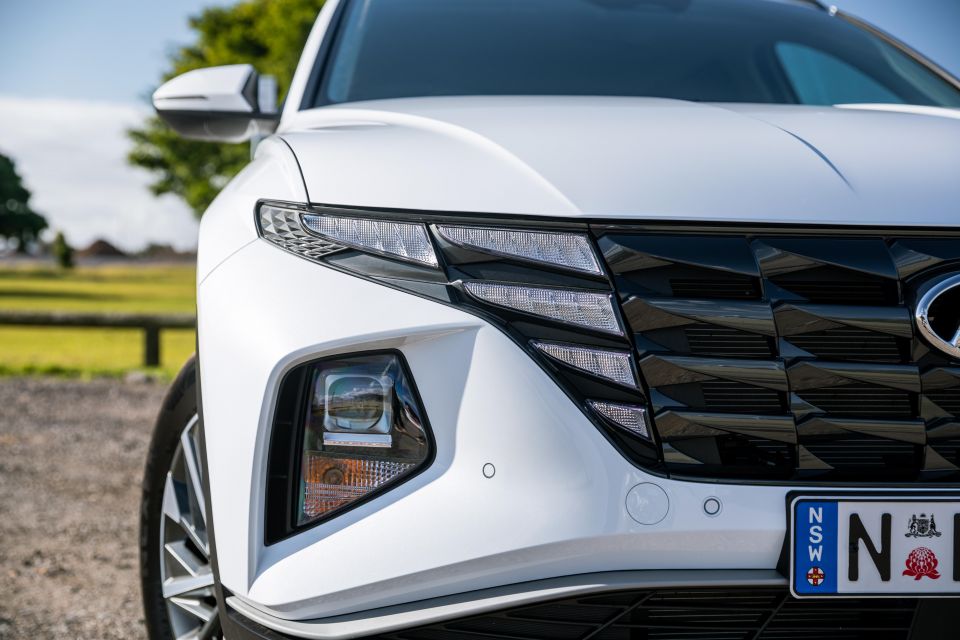
Perhaps some day we’ll think of the glow of a halogen light as being as romantic as candlelight, but for now it’s inferior headlight technology that’s slowly disappearing. What makes the Tucson’s halogen headlights stand out even more – in a bad way – is the fact those intriguing daytime running lights are LED, which produces a crisp, cool light against the weaker, warmer light of the halogens. The mish-mash looks naff.
You’ll need to either add the N Line pack or step up to the Highlander to get LED headlights and tail lights. If you add the N Line pack, you also get:
The RAV4 GXL essentially matches the Tucson’s list of comfort and convenience features bar a power driver’s seat. A CX-5 Maxx Sport goes without keyless entry and front parking sensors, but with front-wheel drive you’re looking at a price $2500 lower. Where the Tucson claws back some ground, however, is in its list of safety equipment.
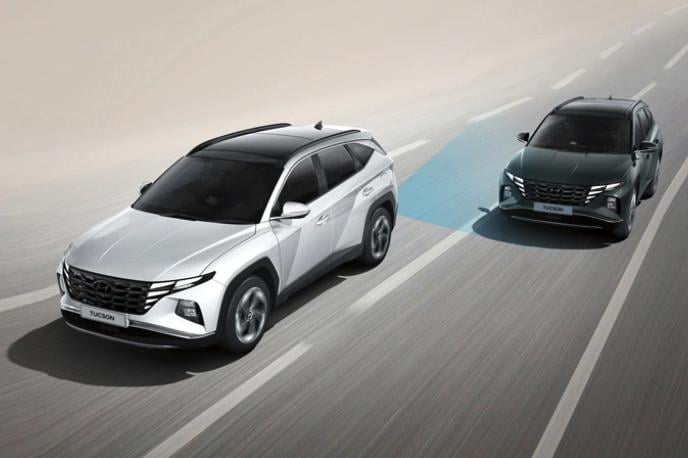
The new Hyundai Tucson has yet to be crash tested by ANCAP or Euro NCAP.
While we don’t yet know what rating it’ll get from those safety authorities, we do know its list of safety equipment has grown longer than that of its predecessor.
Standard equipment on all Tucson models include:
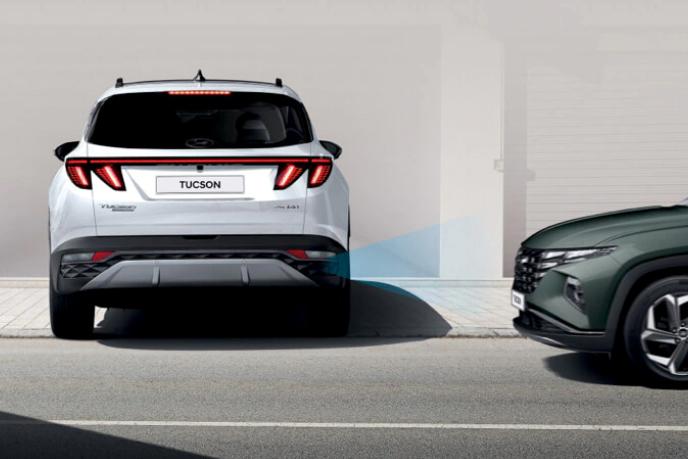
The Elite adds a rear seat occupant alert that uses a radar to detect if you’ve left anybody behind. It also picks up front parking sensors.
Step up to the Highlander and you get even more safety equipment, like reverse AEB and Hyundai’s trick new Blind Spot View Monitor.
Rivals are increasingly offering a full complement of active safety technology but Hyundai has an edge. Instead of blind-spot monitoring and rear cross-traffic alert, which sound an alarm if they detect an imminent collision, the Tucson has blind-spot assist and rear cross-traffic assist which will intervene if you don’t respond to the alarms.
For example, if you go to reverse out of your driveway into the path of an oncoming vehicle and ignore the alarm from the car, it’ll apply the brakes to stop you from getting into an accident. There’s also lane-centring in the form of Hyundai’s Lane Following Assist, while most rivals only offer a simpler lane-keep assist.
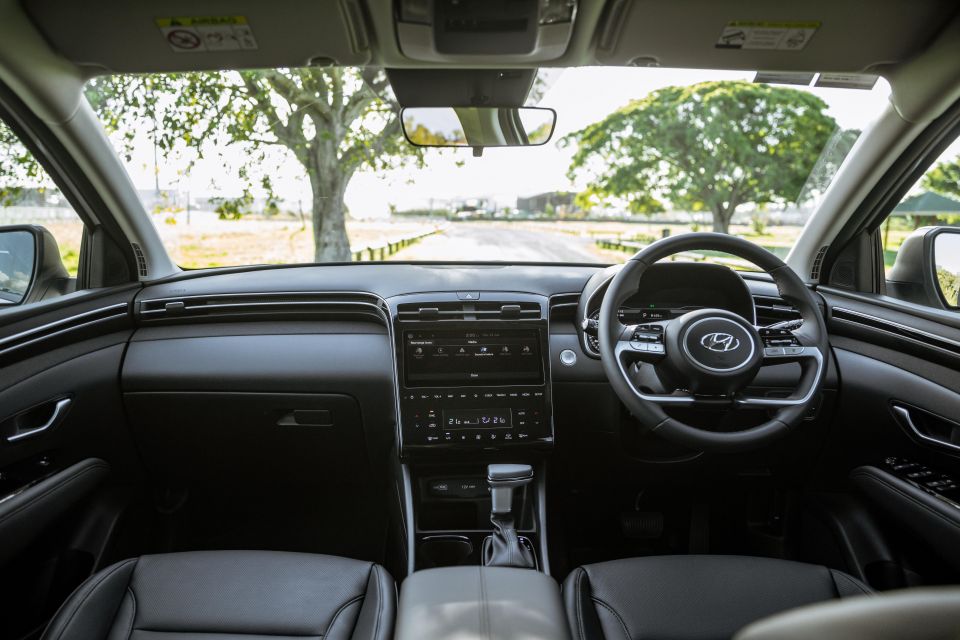
While the exterior of the Tucson polarises, the interior should be more universally appreciated as a step-up over the last car.
Instead of surprise creases, the Tucson’s dashboard layout is simple and restrained, and yet it still looks utterly modern.
There’s a subtle dual-cowl layout to the dash, and the designers have concealed the air vents on either side of the dashboard by integrating them into a strip of brightwork that lines up neatly with similar-looking trim on the doors. Those obsessed with symmetry will definitely appreciate the Tucson’s interior.
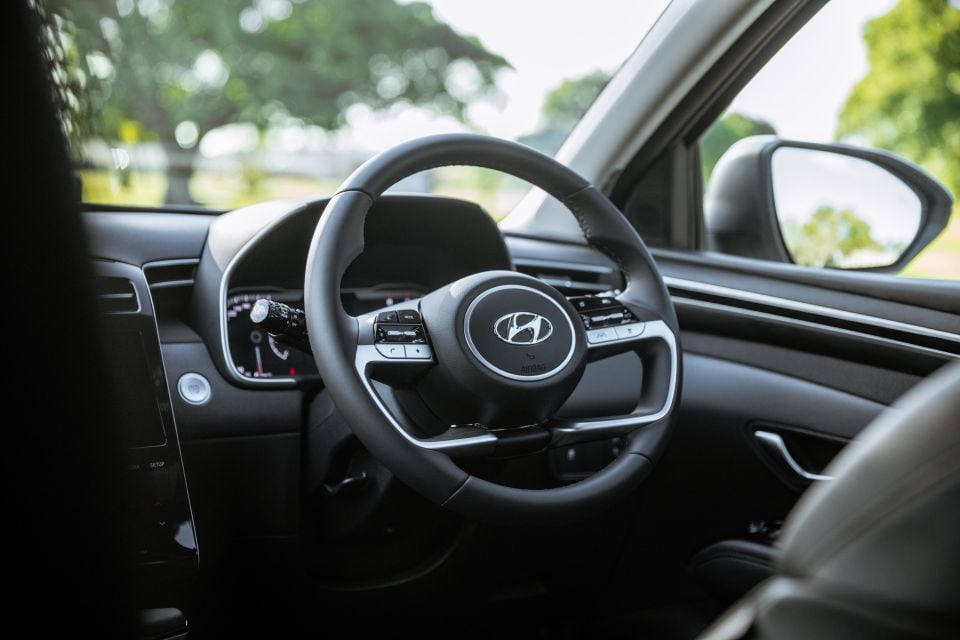

The top half of the dashboard is finished in soft-touch plastics, with cloth accents that also extend to the doors. Usually cloth dashboard trim is matched to cloth upholstery on the seats, but in the Elite you get standard leather upholstery.
Even in boring black, this interior looks modern and elegant. Unfortunately, Hyundai has achieved that crisp, clean in part by replacing most of its switchgear with touch-capacitive switches. These lack haptic feedback and are finished in piano black, which promises smudges and dust aplenty. There are some piano black switches on the centre console, too, though these are physical buttons.
While Hyundai has followed myriad automakers into the murky abyss of piano black trim, it’s eschewed the increasingly du jour tablet-style infotainment screens. Instead, the large, 10.25-inch unit is neatly integrated into the centre stack. It may mean you’ll have to lower your line of sight sometimes, but the look is more aesthetically pleasing.
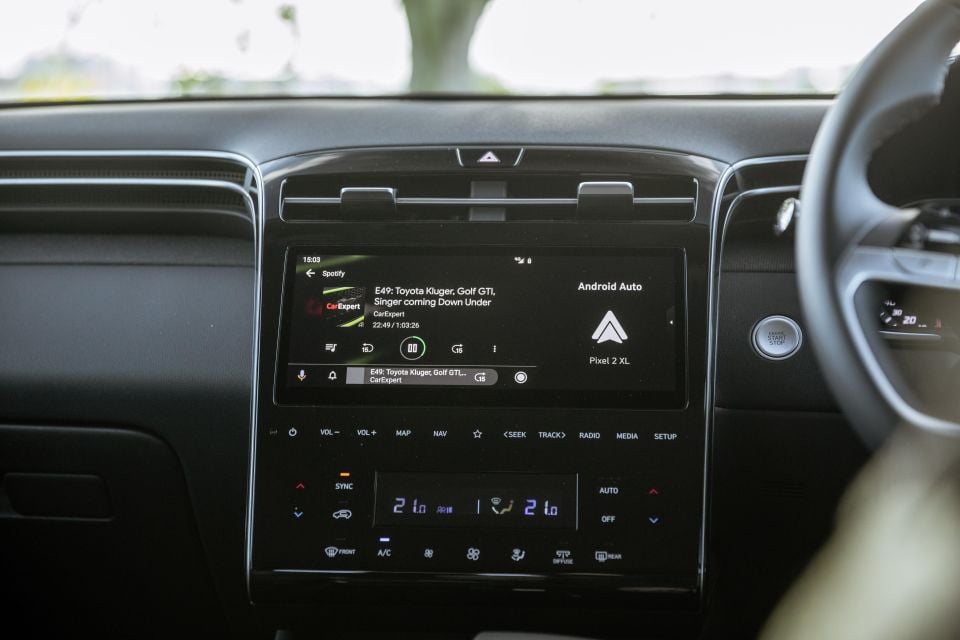
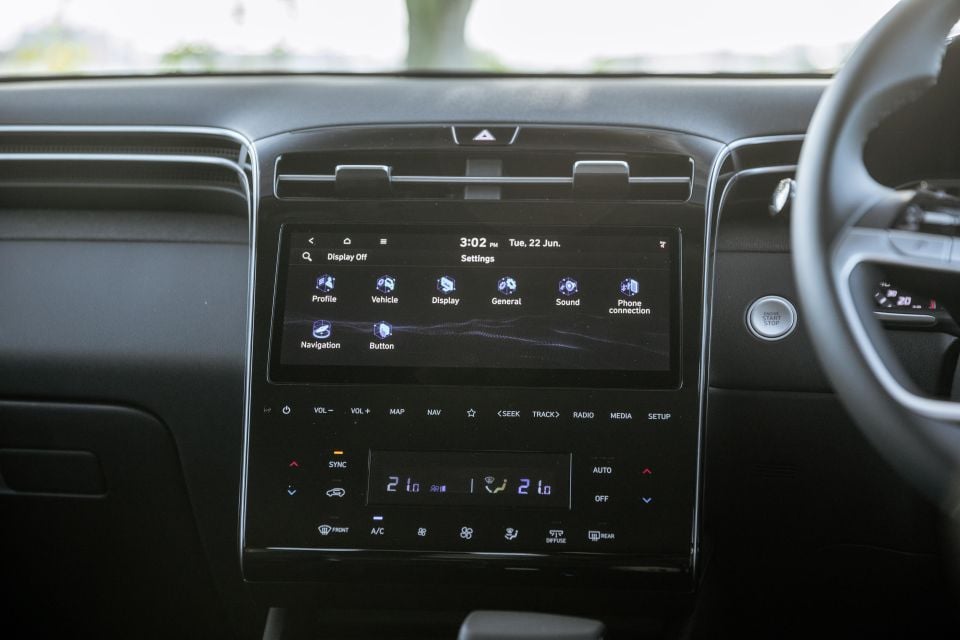
Apple CarPlay takes up the whole screen but Android Auto only takes up two-thirds. This is odd as other cars with similarly large touchscreens have full-screen functionality for Android Auto. It’s the only bugbear we have with the infotainment system, which boasts neat graphics and quick response times.
As is now expected with new Hyundai and Kia products, the larger touchscreen features satellite navigation in lieu of wireless smartphone mirroring. If you don’t want to use a wire to connect your mobile phone, you’ll need to step down to the base Tucson with its smaller 8.0-inch screen. It still features DAB digital radio, however.
Beneath the touchscreen and the climate controls, the centre stack appears to fade away. At the end of the centre console below, you’ll find a wireless charging pad, a 12V outlet and two USB-A outlets.
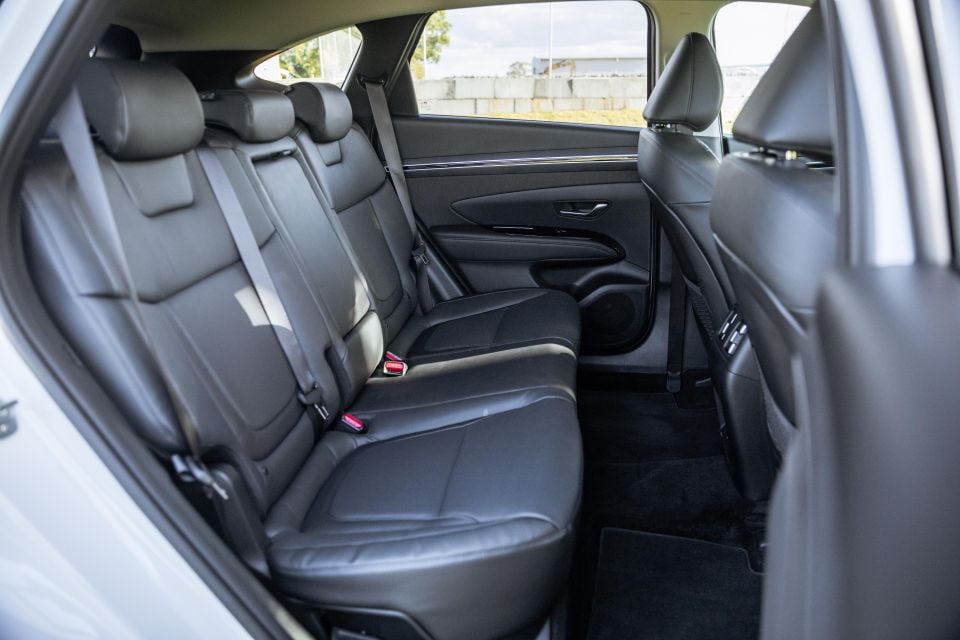
In terms of storage, there’s a centre console bin, two cupholders and bottle holders in each door. All of these are well-sized.
The instrument cluster isn’t all-digital in the base and Elite – for the 10.25-inch digital cluster, you’ll need to step up to the Highlander or add the N Line package. Our car’s analogue cluster has an interesting layout but some of the font choices are a bit early-2000s.
Nowhere is the 85mm longer wheelbase more apparent than the back seat and the boot. Neither was disappointingly small in the old Tucson, but in the new car both areas are utterly capacious.


In addition to legroom that’s quite possibly class-leading, rear seat occupants enjoy air vents, two USB-A outlets, a fold-down centre armrest, and bottle holders in each door. There are also three top-tether anchor points for child seats, plus an ISOFIX point on each outboard seat.
Lift up the tailgate and there’s 539L of boot space, expanding to 1860L with the rear seats folded (measured to the roof).
There’s a 12V outlet back here, while underneath the boot floor is a full-sized spare. That makes the Tucson’s boot space numbers, which are towards the top of the class, all the more impressive.
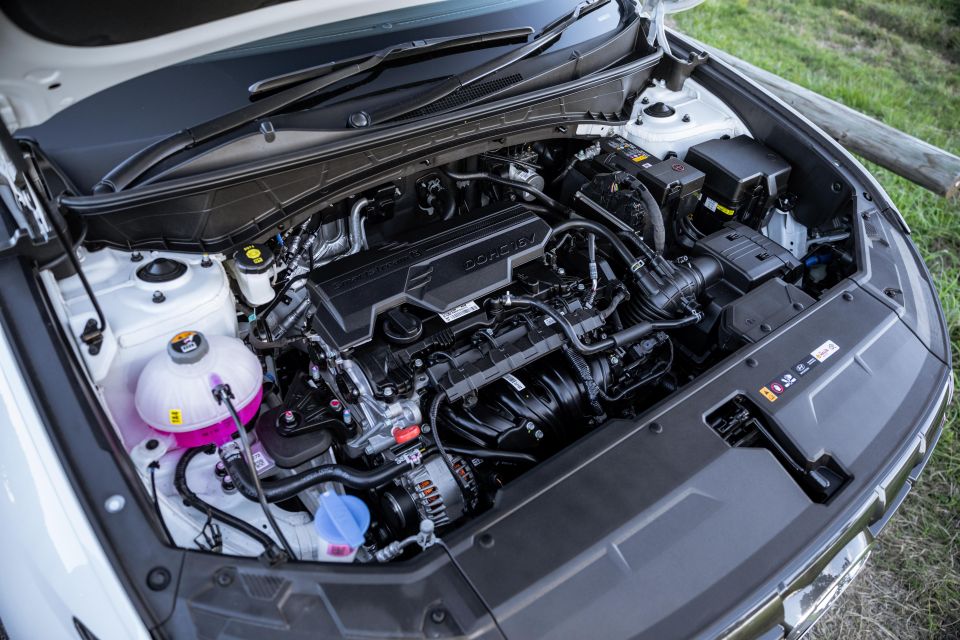
Where expert car reviews meet expert car buying – CarExpert gives you trusted advice, personalised service and real savings on your next new car.
Our tester was powered by the standard naturally-aspirated 2.0-litre four-cylinder engine, which produces 115kW of power and 192Nm of torque. It powers the front wheels only via a six-speed torque converter automatic transmission.
That’s down 7kW and 13Nm on last year’s 2.0-litre four. Hyundai switched from direct- to multi-point injection, while also adding a new electronically-controlled, continuously-variable oil pump said to improve fuel efficiency.
It’s not quite a silver bullet, as fuel economy has increased by 0.2L/100km to 8.1L/100km on the combined cycle. It’s worth noting that, while the Tucson is a larger car in almost every dimension than its predecessor, it weighs essentially the same.
The 2020 Elite 2.0-litre had a tare mass of 1550kg, while the 2021 Elite 2.0-litre weighs 1527kg.
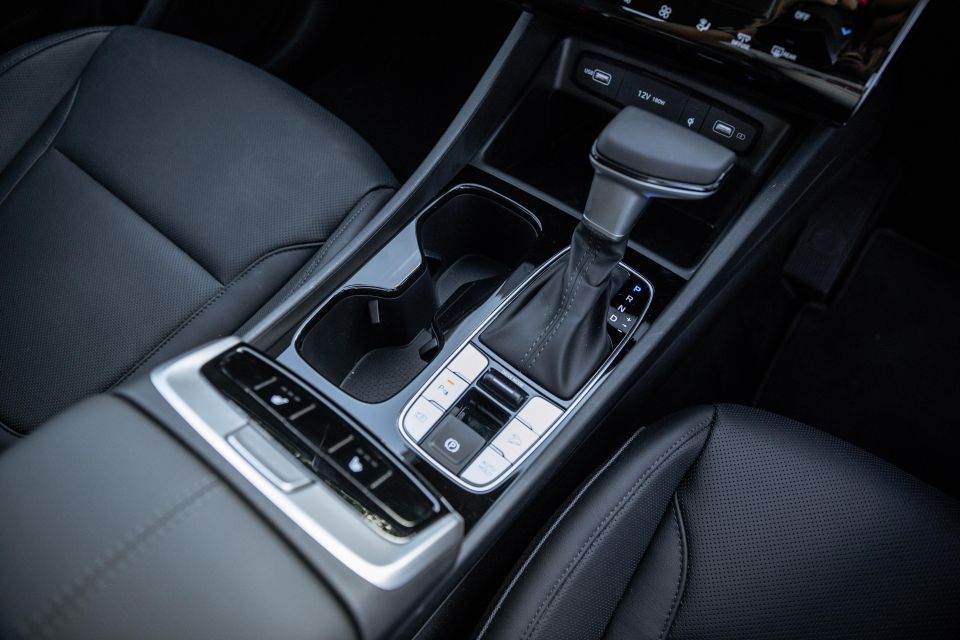
Over a mix of inner-city, suburban and highway driving, we averaged 8.8L/100km.
Hyundai is staggering the rollout of the Tucson’s other engines, with carryover turbocharged 132kW/265Nm 1.6-litre petrol and turbo-diesel 137kW/416Nm 2.0-litre four-cylinder engines coming on board.
The standard 2.0-litre’s outputs are on the lower end for this price point. The Ford Escape is far and away the most powerful sub-$40k SUV with 183kW and 387Nm and an 8.6L/100km combined cycle fuel economy figure, while other punchier vehicles include the 168kW/360Nm MG HS, the 160kW RAV4 Hybrid, and the 150kW/320Nm Haval H6.
The RAV4 bests the Tucson’s fuel economy (4.7L/100km), as does the H6 with front-wheel drive (7.4L/100km).
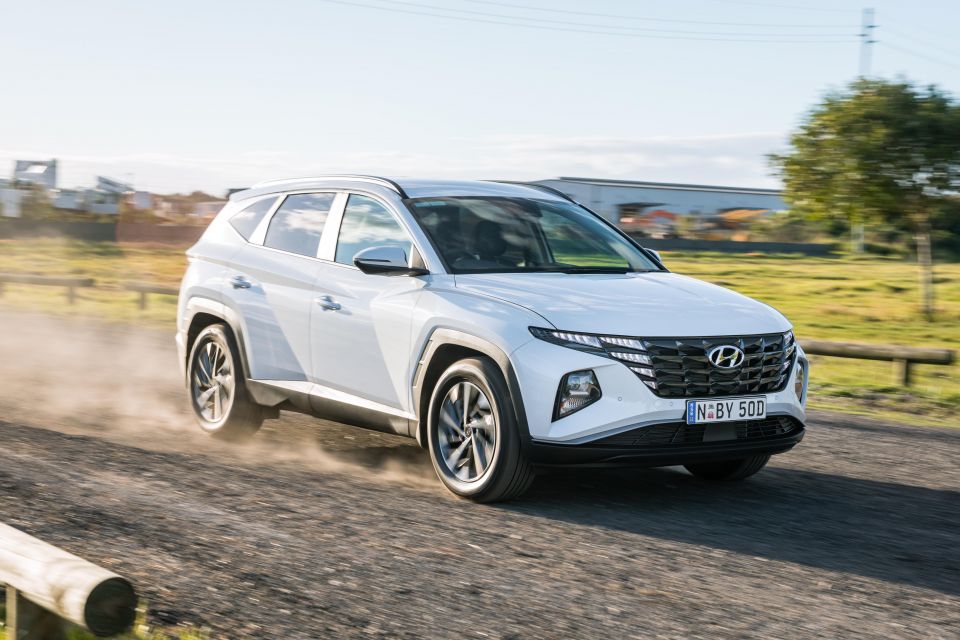
Hyundai has managed to employ an engine with less power in a larger vehicle without the car feeling any slower or noisier. Kudos.
That said, the 2.0-litre four – part of Hyundai’s Smartstream family of engines – is merely adequate.
We had more than one passenger comment that the engine sounded like it was struggling on hills. We blame the uninspiring soundtrack, with the Tucson’s 2.0-litre yet another four-cylinder in the Hyundai Motor Group family that’s no symphony to listen to.
There’s sufficient get-up-and-go off the line and during highway overtaking, though with a full complement of passengers on board the four-cylinder struggles.

The larger 2.5-litre four used as the base engine in North America would be preferable with its higher power and torque figures (139kW and 241Nm), but we can add that to the list of powertrains ‘we wish we could get but won’t’ alongside the hybrid and plug-in hybrid turbocharged 1.6-litre options.
The six-speed automatic transmission could be finessed further. During our time with the Tucson, it had a tendency to slur on shifts between second and third gears, though other shifts were considerably smoother and were always prompt.
The ride quality is mostly good, but the Tucson’s switch to a global suspension tune instead of a local tune is arguably betrayed by the way it responds to poor roads.
Some ruts and expansion joints are more keenly felt than in some other Hyundai products, though we’d stop well short of calling it harsh. For the most part, the ride is comfortable and avoids feeling too firm. It rides more comfortably, for example, than the smaller Kona.
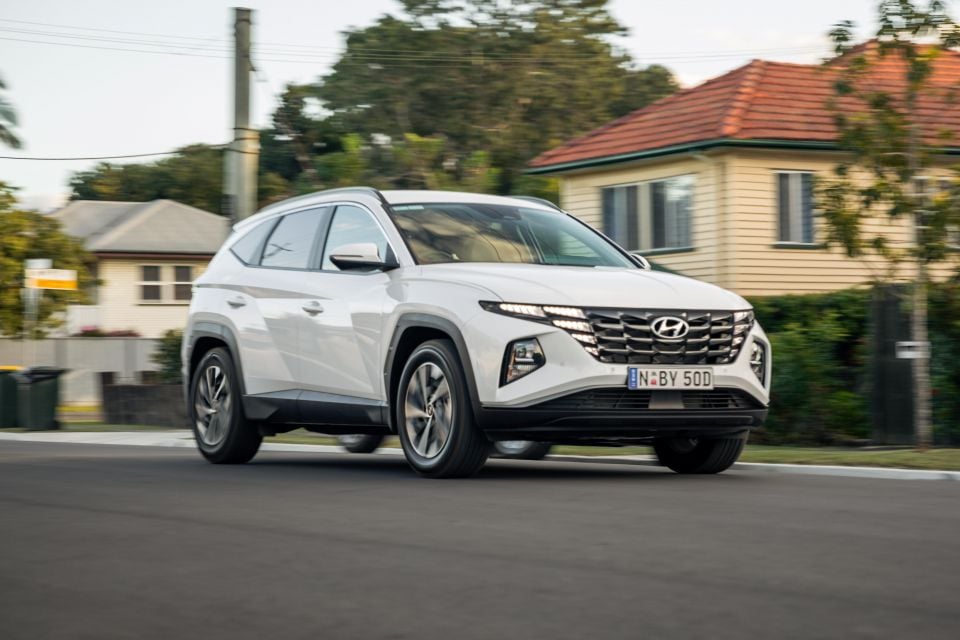
The steering is more impressive, with nice weighting. It’s light at low speeds but it avoids feeling numb as you pick up the pace. Overall handling is competitive for the class – it’s neutral and predictable, though the Tucson’s powertrain stops this from being particularly fun to drive.
Don’t prod the accelerator too much and the Tucson’s cabin is quiet and refined, but that gruff engine note will intrude on that serenity pretty quickly should you need to overtake or get up a hill.
Hyundai’s lane-keep assist is one of the more assertive systems, which may or may not suit your tastes. You can turn it off but it will default to on.
Lane Following Assist has to be manually turned on but, combined with the adaptive cruise control, it works exceptionally well at keeping you in your lane on the highway.
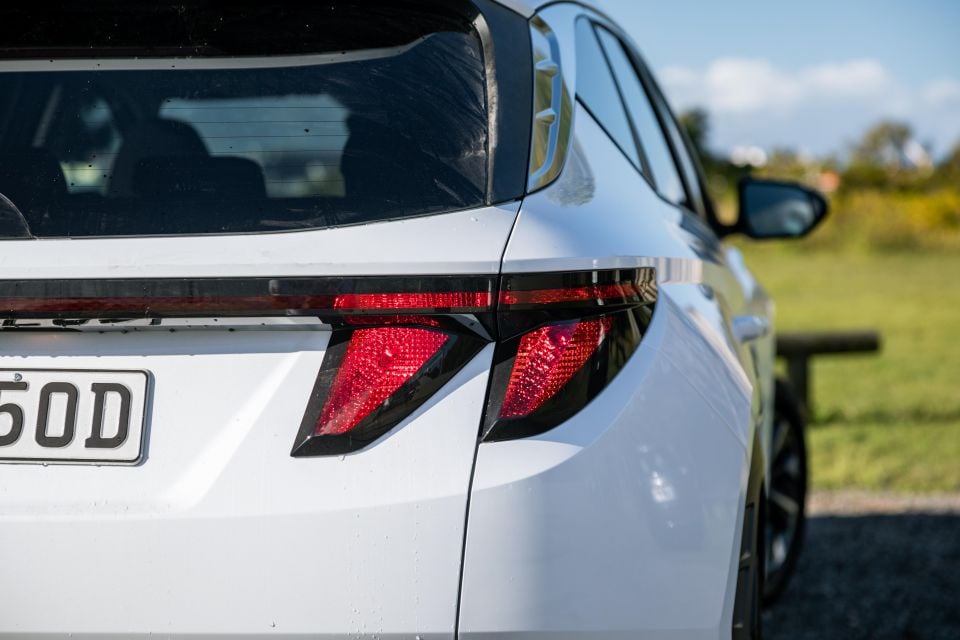
Servicing is required every 12 months or 15,000km. The first five services each cost $319, for a combined cost of $1595 for five years of servicing under Hyundai’s capped-price program.
Hyundai also backs the Tucson with a five-year, unlimited-kilometre warranty.
Some rivals have longer warranties (Korando, Sportage) but the Tucson’s service pricing is on the lower end of the spectrum for this class.

The Tucson has received a substantial upgrade in terms of interior ambience, space and safety equipment, but Hyundai has moved further away from its roots as a challenger brand offering the most metal for your money.
While its safety technology is class-leading and its interior is top-notch, the Tucson is let down by a merely adequate base engine. Hyundai isn’t alone in offering an uninspiring base engine in this segment, with Kia and Mitsubishi also featuring so-so 2.0-litre engines in their entry-level Sportage and Outlander, respectively. To Hyundai’s credit, the 2.0-litre is much improved on the old one and may have enough power for many buyers.
Still, for a car touted in advertising as being a car of the future, a naturally-aspirated four-banger with low outputs doesn’t exactly wow us (nor do the halogen headlights, for that matter). We expect the Chinese to offer more bang for your buck at this price point, but that you can get a similarly-specified RAV4 hybrid for less than $1000 more should give Hyundai pause.
If you’re not a demanding driver, the Tucson’s interior and technology alone should put it on your shortlist. But let’s not forget just how competitive this segment is and how positively teeming it is with options.

Click the images for the full gallery
Where expert car reviews meet expert car buying – CarExpert gives you trusted advice, personalised service and real savings on your next new car.
William Stopford is an automotive journalist with a passion for mainstream cars, automotive history and overseas auto markets.


Matt Campbell
7 Hours Ago


William Stopford
23 Hours Ago


Josh Nevett
3 Days Ago


CarExpert.com.au
4 Days Ago


Josh Nevett
5 Days Ago


Max Davies
5 Days Ago